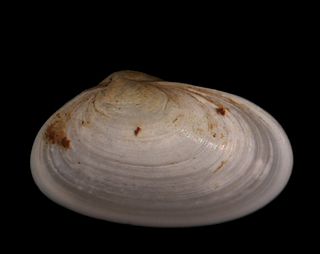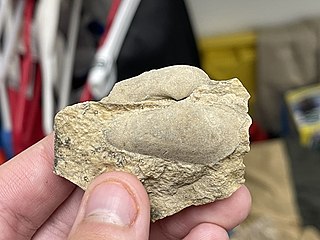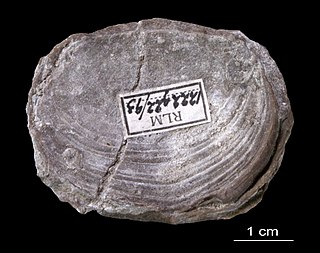
The Rostroconchia is a class of extinct molluscs dating from the early Cambrian to the Late Permian. They were initially thought to be bivalves, but were later given their own class. They have a single shell in their larval stage, and the adult typically has a single, pseudo-bivalved shell enclosing the mantle and muscular foot. The anterior part of the shell probably pointed downward and had a gap from which the foot could probably emerge. Rostroconchs probably lived a sedentary semi-infaunal lifestyle. There were probably more than 1,000 species of members of this class.
Necatia is a genus of the jumping spider family Salticidae. Its only species, Necatia magnidens, is found in southern China.
Praenuculidae is an extinct family of prehistoric bivalves in the superfamily Nuculoidea. Praenuculidae species lived from the early Ordovician, Arenig stage through the Early Devonian Emsian stage. Praenuculidae fossils are found worldwide, present on every continent except Antarctica. Species in this family are thought to have been sessile, attached to the substrate in shallow infaunal marine water environments, where they formed shells of an aragonite composition. The family Praenuculidae was named by A. Lee McAlester in 1969.

Fordilla is an extinct genus of early bivalves, one of two genera in the extinct family Fordillidae. The genus is known solely from Early Cambrian fossils found in North America, Greenland, Europe, the Middle East, and Asia. The genus currently contains three described species, Fordilla germanica, Fordilla sibirica, and the type species Fordilla troyensis.

Pteria colymbus, the Atlantic winged oyster, is a species of bivalve mollusc in the family Pteriidae. It can be found along the Atlantic coast of North America, ranging from North Carolina to Bermuda and Brazil.
Pojetaia is an extinct genus of early bivalves, one of two genera in the extinct family Fordillidae. The genus is known solely from Early to Middle Cambrian fossils found in North America, Greenland, Europe, North Africa, Asia, and Australia. The genus currently contains two accepted species, Pojetaia runnegari, the type species, and Pojetaia sarhroensis, though up to seven species have been proposed. The genera Buluniella, Jellia, and Oryzoconcha are all considered synonyms of Pojetaia.

Tellimya ferruginosa is a species of small marine bivalve mollusc in the family Lasaeidae. It is found on the eastern side of the Atlantic Ocean.
Camya is an extinct genus of early bivalve and is the only genus in the extinct family Camyidae. The genus is known solely from early Middle Cambrian fossils found in Europe. The genus currently contains a solitary accepted species, Camya asy.

Fordilloidea is an extinct superfamily of early bivalves containing two described families, Fordillidae and Camyidae and the only superfamily in the order Fordillida. The superfamily is known from fossils of early to middle Cambrian age found in North America, Greenland, Europe, the Middle East, Asia, and Australia. Fordillidae currently contains two genera, Fordilla and Pojetaia each with up to three described species while Camyidae only contains a single genus Camya with one described species, Camya asy. Due to the size and age of the fossil specimens, Fordillidae species are included as part of the Turkish Small shelly fauna.
Hemiconcavodonta is an extinct genus of bivalve in the extinct family Praenuculidae. The genus is one of three genera in the subfamily Concavodontinae. Hemiconcavodonta is known solely from late Ordovician, Caradoc epoch, fossils found in South America. The genus currently contains a single accepted species, Hemiconcavodonta minuta.
Concavodontinae is an extinct subfamily of prehistoric bivalves in the family Praenuculidae. Concavodontinae species lived from the middle Ordovician, Caradoc epoch through the late Ordovician Ashgill epoch. Concavodontinae fossils are found in Europe and South America, and species are thought to have been stationary attached to substrate in shallow infaunal marine water environments where they formed shells of an aragonite composition. The subfamily Concavodontinae was named by Teresa M. Sánchez in 1999.
Emiliodonta is an extinct genus of bivalve in the extinct family Praenuculidae. The genus is one of three genera in the subfamily Concavodontinae. Emiliodonta is known solely from late Ordovician, Caradocian epoch, fossils found in South America. The genus contains a single accepted species, Emiliodonta cuerdai.
Praenuculinae is an extinct subfamily of prehistoric bivalves in the family Praenuculidae. Praenuculinae species lived from the middle Ordovician through the late Devonian. Praenuculinae fossils are found in Europe, Africa, North America and South America, and species are thought to have been stationary attached to substrate in shallow infaunal marine water environments where they formed shells of an aragonite composition. The subfamily Praenuculinae was named by Teresa M. Sánchez in 1999.
Cuyopsis is an extinct genus of bivalve in the extinct family Praenuculidae. The genus is one of eleven genera in the subfamily Praenuculinae. It is one of three Praenuculinae genera known solely from late Ordivician, Caradoc epoch, fossils found in South America. Cuyopsis currently contains a single accepted species, Cuyopsis symmetricus.
Villicumia is an extinct genus of bivalve in the extinct family Praenuculidae. The genus is one of eleven genera in the subfamily Praenuculinae. It is one of three Praenuculinae genera known solely from late Ordovician, Caradoc epoch, fossils found in South America. Villicumia currently contains a single accepted species, Villicumia canteraensis.
Trigonoconcha is an extinct genus of bivalve in the extinct family Praenuculidae. The genus is one of eleven genera in the subfamily Praenuculinae. It is one of three Praenuculinae genera known solely from Late Ordivician, Caradoc epoch, fossils found in South America. Trigonoconcha currently contains a single accepted species, Trigonoconcha acuta.

Similodonta is an extinct genus of early bivalve in the extinct family Praenuculidae. The genus is one of eleven genera in the subfamily Praenuculinae. Similodonta is known from Middle Ordovician through Middle Silurian fossils found in Europe and North America. The genus currently contains eight accepted species, Similodonta ceryx, Similodonta collina, Similodonta djupvikensis, Similodonta magna, Similodonta recurva, Similodonta spjeldnaesi, Similodonta wahli and the type species Similodonta similis.

Trimerellida is an extinct order of craniate brachiopods, containing the sole superfamily Trimerelloidea and the families Adensuidae, Trimerellidae, and Ussuniidae. Trimerellidae was a widespread family of warm-water brachiopods ranging from the Middle Ordovician to the late Silurian (Ludlow). Adensuidae and Ussuniidae are monogeneric families restricted to the Ordovician of Kazakhstan. Most individuals were free-living, though some clustered into large congregations similar to modern oyster reefs.
The Bardahessiagh Formation is a geologic formation in Northern Ireland. It has been described from a locality lying about 3 km NNE of Pomeroy, south of Craigbardahessiagh. It is now known as comprising the former ‘Bardahessiagh Formation’, or Bardahessiagh Beds and the ‘Junction Beds’ that is underlain by a stratigraphical unit not recognised, until fieldwork by the Ulster Museum staff in 1992. The Bardahessiagh Formation is divided into three units, but the summit of the formation is not known. Field evidence indicates that the local top of the formation is characterised by a thrust contact with the Killey Bridge and Tirnaskea Formation, exposed south of the Well Field, which lies 650 metres SSW of Craigbardahessiagh.

The Famatinian orogeny is an orogeny that predates the rise of the Andes and that took place in what is now western South America during the Paleozoic, leading to the formation of the Famatinian orogen also known as the Famatinian belt. The Famatinian orogeny lasted from the Late Cambrian to at least the Late Devonian and possibly the Early Carboniferous, with orogenic activity peaking about 490 to 460 million years ago. The orogeny involved metamorphism and deformation in the crust and the eruption and intrusion of magma along a Famatinian magmatic arc that formed a chain of volcanoes. The igneous rocks of the Famatinian magmatic arc are of calc-alkaline character and include gabbros, tonalites, granodiorites and trondhjemites. The youngest igneous rocks of the arc are granites.







